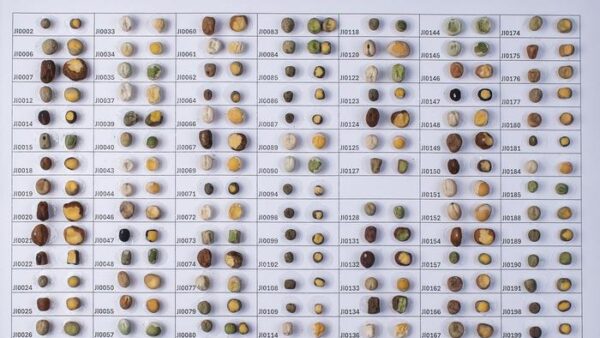Over the past 10 years, there has been incredible progress in CRISPR thanks to enormous private and public investment. Yet, has the technology yet fully delivered on its potential? And what should we expect ahead? Those are the big questions Gusui Wu, Head of Seeds Research at Syngenta, tackled in his presentation at World Agri-Tech in San Francisco, March 20.
“In the past decade, depending on …how you do your calculation, somewhere between four to six billion dollars were invested in start-ups that are applying CRISPR in agriculture. About the same amount of dollars or higher were invested by seed companies big and small to do gene editing in crops. Significant investment or funding has happened in the public sector in plant gene editing research. As of January, there were 53 USDA exemptions of gene-edited traits in about 17 crops,” he said in his presentation.
Yet, he pointed out, at scale delivery of CRISPR-influenced products hasn’t yet occurred. It could even be argued that indicators of investor enthusiasm are waning.
“It’s probably fair to say we have not seen the kind of big impact, large scale commercialization of gene-edited products in the market. And the venture funding has plateaued in the last few years in gene editing in ag,” he said.
The question is: do we still believe CRISPR is a disruptive, revolutionary technology that can bring about new breeding technologies? Do we still believe CRISPR technology is a good investment opportunity that can make the crop of the future happen?
Wu didn’t hesitate for a moment on his answer: “From Syngenta’s perspective, the answer is affirmative.”
To understand today’s reality for gene editing technology and use, Wu said we have to look at the last disruptive, revolutionary technology in plant breeding: transgenic technology for genetically modified traits. That technology was first published in 1983 by Syngenta scientist Mary-Dell Chilton, yet the first transgenic trait wasn’t commercialized until 1996. Why such a delay? The regulatory process is certainly part of the story, but not the whole story. Wu said the reason it took more than 10 years is the fact that the plant transformation technique, as revolutionary as it was, was not in itself sufficient to build a transgenic trait.
“In order to successfully build a transgenic trade, you need plant transformation for sure, but a number of associated application technology were needed [as well].”
In the case of transgenic traits, the associated technologies included trait gene engineering, plant expression tools, and trait introgression technologies to introduce traits into elite varieties of hybrids.
The delay in CRISPR’s uptake and commercial application is similar.
“CRISPR technology itself is not new breeding technology. Let’s be clear about that. It’s simply a tool that enables a lot of breeding technologies that can happen,” Wu said.
The good news, he added, is that there has been significant progress in the last handful of years in terms of taking CRISPR technology the next step, which would enable new breeding technologies to happen. He shared some examples from the Syngenta team that illustrate that CRISPR is finally reaching the turning point necessary for true commercialization.
The first significant signpost is the diversification of CRISPR-Cas systems.
“Cas9 is efficient but has a lot of limitations. We need diversified CRISPR-Cas systems in order for new breeding technology to happen,” he said.
Already, a number of companies — Wu referenced Pairwise — have developed alternative CRISPR systems. Syngenta has developed a Cas12-based system that is as efficient at Cas9 but overcomes many of Cas9’s limitations, including what Wu called its murky IP path.
“Traits can be developed with gene editing today with the current technology, if those edits are simple,” Wu said.
For example, Syngenta is currently working on several key traits, including extended shelf-life and disease resistance in tomato, and Asian soybean rust resistance.
“We see in the pipeline a lot of new traits that are being developed by various entities, public and private. There is a democratization of the technology, which is different than [how] GM technology happened in the last couple of decades, which is a good thing,” Wu said.
The second area of notable opportunity, which is still largely overlooked, is that CRISPR can improve the efficiency of the breeding process.
“This has not been widely appreciated,” said Wu.
For example, when gene editing technology is combined into one step with a hybrid breeding process called the doubled haploid technique, then applied to trait introgression, it reduces the time for trait introgression from six or seven generations to one.
“One cross, you can introduce the trait into any elite varieties or hybrids you would like,” said Wu.
Perhaps the largest opportunity ahead for CRISPR is how gene editing can be applied to complex traits where you need complex, multiple gene modifications or pathways.
“This can happen today; we see the opportunity and the potential,” Wu said. “With gene editing in combination with machine learning, now even artificial intelligence, we can now create designed genetic variations. The variations can give you outcomes with high predictability and today we see examples demonstrating that. So, this opportunity is going to be huge.”
The next stage for CRISPR is likely to be its most exciting, and its opportunity to make its biggest impact on the market.
“I hope we have passed the stages of inflated expectations or the troughs of disillusionment and we have entered the stage of enlightenment,” said Wu. “From investors’ perspective, we should remain optimistic about next five years or next 10 years in terms of the innovation and the investment opportunities.”













